线性有界算子序列的一致强(弱)收敛
- 格式:docx
- 大小:28.36 KB
- 文档页数:2
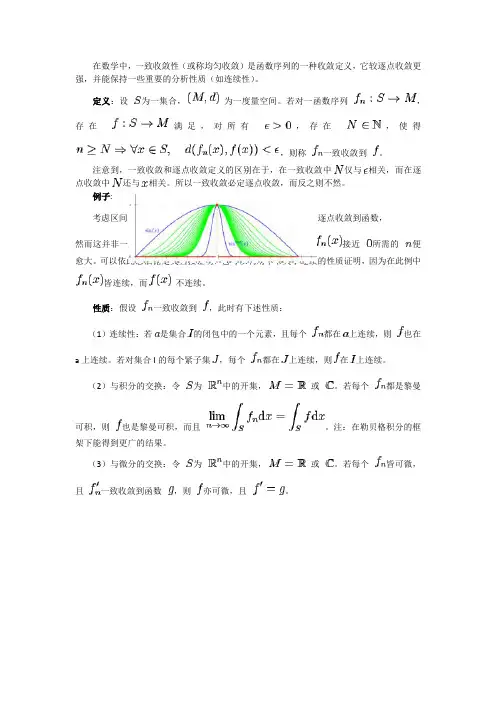
在数学中,一致收敛性(或称均匀收敛)是函数序列的一种收敛定义,它较逐点收敛更强,并能保持一些重要的分析性质(如连续性)。
定义:设为一集合,为一度量空间。
若对一函数序列,存在满足,对所有,存在,使得
,则称一致收敛到。
注意到,一致收敛和逐点收敛定义的区别在于,在一致收敛中仅与相关,而在逐点收敛中还与相关。
所以一致收敛必定逐点收敛,而反之则不然。
例子:
考虑区间上的函数序列,它逐点收敛到函数,
然而这并非一致收敛。
直观地想像:当愈靠近,使接近所需的便愈大。
可以依此想法循定义直接证明,也可以利用下节关于连续的性质证明,因为在此例中皆连续,而不连续。
性质:假设一致收敛到,此时有下述性质:
(1)连续性:若是集合的闭包中的一个元素,且每个都在上连续,则也在a上连续。
若对集合I的每个紧子集,每个都在上连续,则在上连续。
(2)与积分的交换:令为中的开集,或。
若每个都是黎曼
可积,则也是黎曼可积,而且。
注:在勒贝格积分的框架下能得到更广的结果。
(3)与微分的交换:令为中的开集,或。
若每个皆可微,且一致收敛到函数,则亦可微,且。
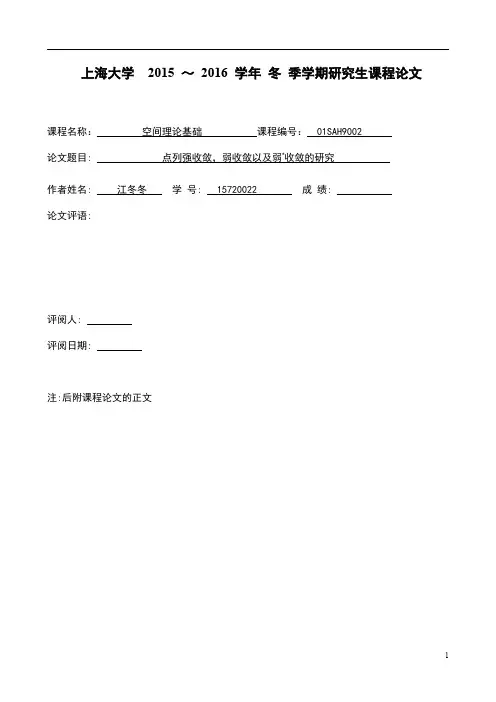
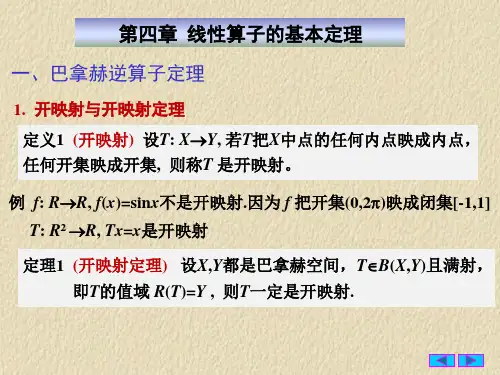
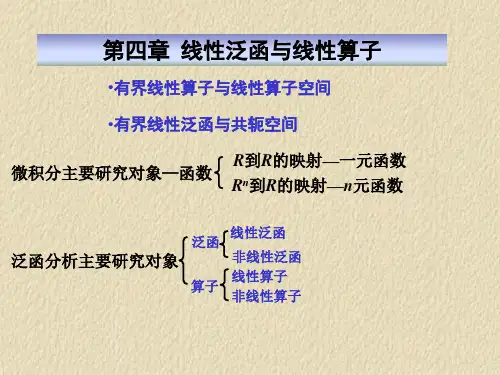
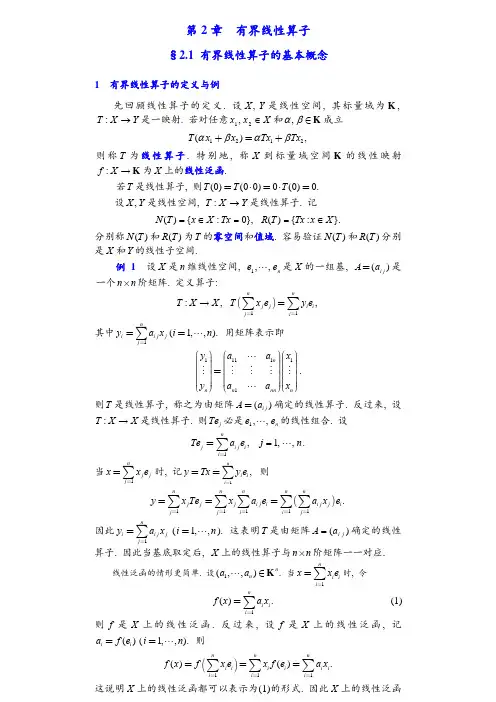
![Banach空间中线性算子核逆的一致有界性与收敛性[英文]](https://uimg.taocdn.com/593314a9710abb68a98271fe910ef12d2af9a9d7.webp)
应用数学MATHEMATICA APPLICATA2021,34(1):216-223The Uniform Boundedness and Convergence for the Core Inverses of Linear Operators in Banach SpacesZHAO Yayuan(赵亚媛),CHEN Saijie(陈赛杰)ZHU Lanping(朱兰萍),HUANG Qianglian(黄强联) (School of Mathematical Sciences,Yangzhou University,Yangzhou225002,China)Abstract:The main topic of this paper is the relationship between uniform boundednessand convergence of the core inverses of linear operators in Banach spaces.Wefirst obtainthe equivalence of the uniform boundedness and convergence for core inverse and we givethe expression of core inverse.Secondly,we investigate the stable perturbation for the coreinverse and prove that the stable perturbation and the continuity of the core inverse areequivalent.As applications,we also give the continuity characterization for the core inverseoffinite rank operators and derive the sufficient and necessary condition for the core inverseof the perturbed operator to have the simplest possible expression.Key words:Core inverses;Uniform boundedness;Convergence;Generalized inverse;Stable perturbationCLC Number:O177.91AMS(2000)Subject Classification:47A55;47A58Document code:A Article ID:1001-9847(2021)01-0216-081.Introduction and PreliminariesLet X,Y be Banach spaces and B(X,Y)denote the Banach space of all bounded linear operators from X into Y.We write B(X)as B(X,X).For any T∈B(X,Y),we denote the null space and the range of T by N(T)and R(T),respectively.The identity operator will be denoted by I.Recall that an operator S∈B(Y,X)is said to be a generalized inverse of T∈B(X,Y) if S satisfies:(1)T ST=T and(2)ST S=S.A generalized inverse of T is usually denoted by T+.While the generalized inverse may not exist and it is not unique even if it exists.In order to force its uniqueness,some further conditions have to be imposed.Let us recall definitions of three important generalized inverses.∗Received date:2020-03-02Foundation item:Supported by the National Natural Science Foundation of China(11771378, 11871064,11971419);the Yangzhou University Foundation for Young Academic Leaders(2016zqn03);the Postgraduate Research and Practice Innovation Program of Yangzhou University(XKYCX19-057) Biography:ZHAO Yayuan,female,Han,Anhui,major in functional analysis.Corresponding auther:HUANG Qianglian.No.1ZHAO Yayuan,et al.:The Uniform Boundedness and Convergence for the Core Inverses217Definition1.1Let X and Y be Hilbert spaces.An operator S∈B(Y,X)is called the Moore-Penrose inverse of T∈B(X,Y)if S satisfies the Penrose equations:(1)T ST=T;(2)ST S=S;(3)(T S)∗=T S and(4)(ST)∗=ST,where T∗denotes the adjoint operator of T.The Moore-Penrose inverse of T is always written by T†,which is uniquely determined if it exists.Definition1.2Let X be a Banach space.An operator S∈B(X)is said to be the group inverse of T∈B(X),always denoted by T♯,if S satisfies(1)T ST=T;(2)ST S=S and(5)T S=ST.The core inverse is a generalized inverse somehow between the Moore-Penrose inverse and the group inverse,which was introduced by Baksalary and Trenkler for the matrix T satisfying Rank T2=Rank T♯.In[2],Raki´c,Dinˇc i´c and Djordjevi´c extended it to the operator on a Hilbert space:Definition1.3[2]Let X be a Hilbert space.An operator S∈B(X)is said to be the core inverse of T∈B(X),denoted by T#⃝,if S satisfies(1)T ST=T;(2)ST S=S;(3)(T S)∗=T S;(6)ST2=T and(7)T S2=S.For the invertible operator,by the well known Banach Lemma and the identity:−T−1n=−T−1m(T m−T n)T−1n,T−1mwe can get the following theorems.Theorem1.1Let T∈B(X,Y)be invertible and T−1its inverse.If T n∈B(X,Y) satisfies T n→T,then there exists N∈N,such that for all n≥N,T n is invertible and=T−1[I+(T n−T)T−1]−1=[I+T−1(T n−T)]−1T−1.T−1n→T−1,which means that the mapping T→T−1is continuous. Furthermore,T−1nTheorem1.2Let T n and T∈B(X,Y)satisfy T n→T.If T n is invertible and ∥T−1n∥<+∞,then T is invertible and T−1n→T−1.supn∈N∥T−1n∥< Hence we can claim that T is invertible if and only if T n is invertible with supn∈N→T−1.It is natural to ask whether similar results hold for various +∞,in this case,T−1ngeneralized inverses.Such problems of expression,boundedness and convergence have been investigated for the generalized inverse in[3–11],the Moore-Penrose inverse in[6–8,11–15], the group inverse in[3,8,11,16–18]and the core inverse in[1,2,19].Especially,Koliha[14], ZHU,ZHU and HUANG[11]proved the equivalence between the uniform boundedness and convergence for the Moore-Penrose inverse and group inverse,respectively.In this paper,we shall investigate the same problems for the core inverse.By utilizing the stable perturbation,we obtain the equivalence of the uniform boundedness and convergence for core inverse and some expression results.For the stable perturbation of the generalized inverse,we have the following theorem which plays a crucial role in our proof.Theorem1.3[8]Let X and Y be Banach spaces and T+∈B(Y,X)be a generalized inverse of T∈B(X,Y).Assume that I+δT T+:Y→Y be bijective withδT∈B(X,Y). Then the following statements are equivalent:1)B=T+(I+δT T+)−1=(I+T+δT)−1T+is a generalized inverse of T=T+δT;2)T is a stable perturbation of T,i.e.,R(T)∩N(T+)={0};3)Y=R(T)⊕N(T+);218MATHEMATICA APPLICATA20214)Y=R(T)˙+N(T+);5)X=N(T)⊕R(T+);6)X=N(T)+R(T+);7)R(T)=T R(T+).In the next section,wefirst prove that T is core invertible if and only if T n is coreinvertible with supn∈N ∥T#⃝n∥<+∞and give a concrete expression of T#⃝.Secondly,we provethe equivalence between the stable perturbation and the continuity for the core inverse.As applications,we also derive the continuity characterization for the core inverse offinite rank operators and the characterization for the core inverse of the perturbed operator to have the simplest possible expression.For the null space-preserving or the dimension of null space-preserving perturbation,we give a complete answer to the problem proposed in[19].2.Main ResultsAs mentioned above,an operator T is invertible if and only if T n is invertible with supn∈N∥T−1n∥<+∞.It turns out that the same property is also enjoyed by the core inverse.Theorem2.1Let X be a Hilbert space and T n,T∈B(X)with T n→T.If the coreinverse T#⃝nexists,then the following statements are equivalent:1)supn∈N∥T#⃝n∥<+∞;2)T has the core inverse T#⃝satisfying T#⃝n→T#⃝.In this case,for all sufficiently large n,T#⃝=W−1n T S n M−1n,where S n=T#⃝n [I+(T−T n)T#⃝n]−1,W n=T S n−T−I and M n=I−T S n−(T S n)∗.Proof It is obvious to see2)⇒1)and we only need to prove1)⇒2).By the definition of the core inverse,we can getT∗n (I−T n T#⃝n)=T∗n−T∗n(T n T#⃝n)∗=T∗n−(T n T#⃝n T n)∗=0and(I−T#⃝mT m)T m=T m−T#⃝m T2m=0.Then it follows from supn∈N∥T#⃝n∥<+∞andT#⃝m−T#⃝n=T#⃝m T n T#⃝n−T#⃝m T m T#⃝n+T#⃝m−T#⃝m T n T#⃝n+T#⃝m T m T#⃝n−T#⃝n=T#⃝m(T n−T m)T#⃝n+T#⃝m(I−T n T#⃝n)−(I−T#⃝m T m)T#⃝n=T#⃝m(T n−T m)T#⃝n+T#⃝m T m T#⃝m(I−T n T#⃝n)−(I−T#⃝m T m)T n(T#⃝n)2=T#⃝m(T n−T m)T#⃝n+T#⃝m(T m T#⃝m)∗(I−T n T#⃝n)−(I−T#⃝m T m)T n(T#⃝n)2=T#⃝m(T n−T m)T#⃝n+T#⃝m(T#⃝m)∗T∗m(I−T n T#⃝n)−T#⃝m(T#⃝m)∗T∗n(I−T n T#⃝n)−(I−T#⃝m T m)T n(T#⃝n)2+(I−T#⃝m T m)T m(T#⃝n)2=−T#⃝m(T m−T n)T#⃝n+T#⃝m(T#⃝m)∗(T∗m−T∗n)(I−T n T#⃝n)+(I−T#⃝mT m)(T m−T n)(T#⃝n)2that{T#⃝n}is a Cauchy sequence in B(X).Since B(X)is complete,we can assume T#⃝n→S∈B(X)and take the limit infive equations in the definition of T#⃝n.Then S is the coreinverse of T and T#⃝n→S=T#⃝.HenceI−T#⃝nT n−T#⃝T→I−2T#⃝T.No.1ZHAO Yayuan,et al.:The Uniform Boundedness and Convergence for the Core Inverses219Noticing(I−2T#⃝T)2=I,we know that I−2T#⃝T is invertible.Thus there exists N∈N, such that for all n>N,I−T#⃝nT n−T#⃝T is invertible and∥(T−T n)T#⃝n∥≤∥T−T n∥∥T#⃝n∥≤12<1.By the Banach Lemma,I+(T−T n)T#⃝nis invertible.Therefore,R(T)=R[T(I−T#⃝nT n−T#⃝T)]=R[T(T#⃝n T n)]=T R(T#⃝n T n)=T R(T#⃝n).Since I+(T−T n)T#⃝nis invertible,from Theorem1.3,S n=T#⃝n [I+(T−T n)T#⃝n]−1is a generalized inverse of T.Observing that(T T#⃝−T−I)(T#⃝T−T#⃝−I)=(T#⃝T−T#⃝−I)(T T#⃝−T−I)=I,[I−T T#⃝−(T T#⃝)∗]2=(I−2T T#⃝)2=I,we can get that T T#⃝−T−I and I−2T T#⃝are invertible.SinceT S n−T−I→T T#⃝−T−IandI−T S n−(T S n)∗→I−T T#⃝−(T T#⃝)∗=I−2T T#⃝,we know that for all sufficiently large n,W n=T S n−T−I and M n=I−T S n−(T S n)∗are invertible.To complete the proof,we shall show thatV n=W−1n T S n M−1nis the core inverse of T.In fact,M∗n=M n and if we set Q n=T S n,then Q n W n=−T=−Q n T,W n Q n=−T2S n=−T Q n,W n T=−T2,Q n M n=−Q n Q∗n =M n Q∗n,M n Q n=−Q∗nQ n=Q∗nM n,M n T=−Q∗nT.HenceT W−1n =−Q n,M−1nQ n=Q∗nM−1n,Q n M−1n=M−1nQ∗n.Thus,by the definition of V n,T V n=T W−1n Q n M−1n=−Q2nM−1n=−Q n M−1n,V n T=W−1n Q n M−1nT=W−1nM−1nQ∗nT=−W−1nTand soT V n T=−Q n M−1n T=−M−1nQ∗nT=T,V n T V n=−W−1n T V n=W−1nQ n M−1n=V n,(T V n)∗=(−Q n M−1n )∗=−M−1nQ∗n=−Q n M−1n=T V n,V n T2=−W−1n T T=W−1nW n T=T.Therefore,V n is a generalized inverse of T andR(V n)=R(W−1n T S n M−1n)=W−1nT R(S n)=W−1nT R(T#⃝n)=W−1n R(T)=W−1nR(T T#⃝)=W−1nR(T2)=W−1nR(W n T)=R(T)=R(T V n)=N(I−T V n).This imples(I−T V n)V n=0and so T V2n=V n.Thus,V n is the core inverse of T.The proofis complete.Theorem2.1provides a sufficient and necessary condition for the core invertibility of T nto imply the core invertibility of T and T#⃝n→T#⃝.Naturally,we can propose the following220MATHEMATICA APPLICATA 2021problems:Can the core invertibility of T imply the core invertibility of T n ?If T n is also coreinvertible,does the core inverse T #⃝n converge or T #⃝n →T #⃝?The following two examples showthat the answers are no in general.Example 2.1Let T = 000113−1−1−3 and T n = 1n 01n 113−1+1n−1−3+1n ,then T n →T and T is core invertible with T #⃝= 0000−1414014−14.But T n is not core invertible since Rank T n =2and Rank T 2n =1.Example 2.2Let T = 000112−1−1−2 and T n = 1n 01n 112−1+1n −1−2+1n,then T n →T ,both T and T n are core invertible with T #⃝= 0000−1212012−12and T #⃝n =13 −2n +1−n +2−n −1−6n +2−3n +4−3n −24n −12n −22n +1 .Obviously,T #⃝n is unbounded and divergent.The next theorem shows that if T is core invertible,then T n is core invertible with T #⃝n →T #⃝if and only if T n is a stable perturbation of T .Moreover,a concrete expression of T #⃝n is also obtained.Theorem 2.2Let X be a Hilbert space and T ∈B (X )be core invertible.Let T n ∈B (X )satisfy T n →T ,then the following statements are equivalent:1)For all sufficiently large n ,T n is a stable perturbation of T ,i.e.,R (T n )∩N (T #⃝)={0};2)There exists N ∈N ,such that for all n ≥N ,T n is core invertible withT #⃝n→T #⃝.In this case,for all sufficiently large n ,T #⃝n =K −1n T n B n G −1n ,where B n =T #⃝[I +(T n −T )T #⃝]−1,K n =T n B n −T n −I and G n =I −T n B n −(T n B n )∗.Proof 1)⇒2)It follows from Theorem 1.3that,for all sufficiently large n ,I +(T n −T )T #⃝is invertible and B n =T #⃝[I +(T n −T )T #⃝]−1=[I +T #⃝(T n −T )]−1T #⃝is a generalized inverse of T n .Similar to the proof of Theorem 2.1,we can prove that for all sufficiently large n ,K n =T n B n −T n −IandG n =I −T n B n −(T n B n )∗No.1ZHAO Yayuan,et al.:The Uniform Boundedness and Convergence for the Core Inverses221are invertible,K−1n T n B n G−1nis the core inverse of T n,and obviously,T#⃝n =K−1nT n B n G−1n→(T#⃝T−T#⃝−I)T T#⃝(I−2T T#⃝)=T#⃝.2)⇒1)For all sufficiently large n,we know that both I+(T n−T)T#⃝and I−T#⃝n T n+ T#⃝T are invertible,andR(T n)=R[T n(I−T#⃝nT n+T#⃝T)]=R(T n T#⃝T)=T n R(T#⃝),By Theorem1.3,we get R(T n)∩N(T#⃝)={0}.The proof is complete.As an application,we can give a characterization that T n is core invertible with T#⃝n→T#⃝forfinite rank operators.Corollary 2.1Let T∈B(X)be offinite rank.If T n→T and T is core invertible, then the following statements are equivalent:1)Rank T n=Rank T for all sufficiently large n;2)There exists N∈N,such that for all n≥N,T n is core invertible withT#⃝n→T#⃝;3)There exists N∈N,such that for all n≥N,T n is core invertible withsupn∈N∥T#⃝n∥<+∞.In this case,T#⃝n=(T n B n−T n−I)−1T n B n[I−T n B n−(T n B n)∗]−1.Proof It suffices to prove1)⇔2).Without loss of generality,we can assume that I+(T n−T)T#⃝is invertible.It follows from[I+(T n−T)T#⃝]T=T n T#⃝Tthat dim R(T)=dim R(T n T#⃝T)=dim T n R(T#⃝T)=dim T n R(T#⃝)=dim R(T n T#⃝).If Rank T n=Rank T,thendim R(T n)=dim R(T n T#⃝).Since R(T n T#⃝)⊆R(T n),we get R(T n)=R(T n T#⃝)=T n R(T#⃝).Using Theorem1.3,we can have R(T n)∩N(T#⃝)={0}.Hence by Theorem2.2,2)holds.Conversely,if T n is core invertiblewith T#⃝n→T#⃝,then T n T#⃝n→T T#⃝.Hence for all sufficiently large n,I−T n T#⃝n+T T#⃝andI−T T#⃝+T n T#⃝nare invertible.ThusR(T n T#⃝n )=R[T n T#⃝n(I−T n T#⃝n+T T#⃝)]=R(T n T#⃝nT T#⃝)andR(T T#⃝)=R[T T#⃝(I−T T#⃝+T n T#⃝n )]=R(T T#⃝T n T#⃝n).Therefore,dim R(T n T#⃝n )≤dim R(T T#⃝)and dim R(T T#⃝)≤dim R(T n T#⃝n),i.e., Rank T n=Rank T.The proof is complete.It is also noteworthy that we provide a direct and brief proof in Corollary2.1and we do not use the Finite Rank Theorem[9].Next,we can give the characterization for the core inverse T#⃝nto have the simplest possible expression.Corollary2.2Let X be a Hilbert space and T∈B(X)be core invertible.If T n∈B(X) satisfies T n→T,then for all sufficiently large n,T n is core invertible andT#⃝n=T#⃝[I+(T n−T)T#⃝]−1=[I+T#⃝(T n−T)]−1T#⃝if and only if T n=T T#⃝T n.222MATHEMATICA APPLICATA2021Proof Sufficiency.If T n=T T#⃝T n,then R(T n)⊂R(T)andR(T n)∩N(T#⃝)⊆R(T)∩N(T#⃝)={0}.By Theorem1.3,B n=T#⃝[I+(T n−T)T#⃝]−1=[I+T#⃝(T n−T)]−1T#⃝is a generalized inverse of T n.Noticing B n=T T#⃝B n=B n T T#⃝andT n B n=T T#⃝T n T#⃝[I+(T n−T)T#⃝]−1=T T#⃝[I+(T n−T)T#⃝][I+(T n−T)T#⃝]−1=T T#⃝,B n T n T T#⃝=[I+T#⃝(T n−T)]−1T#⃝T n T T#⃝=[I+T#⃝(T n−T)]−1[I+T#⃝(T n−T)]T T#⃝=T T#⃝,we can get[I−T n B n−(T n B n)∗]2=(I−2T T#⃝)2=I and(T n B n−T n−I)(B n T n−B n−I)=I+T n B2n T n+B n−T n B2n−B n T n=I+T T#⃝B n T n+B n−T T#⃝B n−B n T n=I+B n T n+B n−B n−B n T n=I,(B n T n−B n−I)(T n B n−T n−I)=I+B n T2n B n+T n−B n T2n−T n B n=I+B n T n T T#⃝+T n−B n T n T T#⃝T n−T T#⃝=I+T T#⃝+T n−T T#⃝T n−T T#⃝=I+T T#⃝+T n−T n−T T#⃝=I.Hence[I−T n B n−(T n B n)∗]−1=I−2T T#⃝and(T n B n−T n−I)−1=B n T n−B n−I.Therefore, by Theorem2.2,we have=(T n B n−T n−I)−1T n B n[I−T n B n−(T n B n)∗]−1T#⃝n=(B n T n−B n−I)T T#⃝(I−2T T#⃝)=(B n T n T T#⃝−B n T T#⃝−T T#⃝)(I−2T T#⃝)=−B n+2B n T T#⃝=B n.Necessity.If B n is the core inverse of T n,then)=R(B n)=R(T#⃝)=R(T)=R(T T#⃝)=N(I−T T#⃝).R(T n)=R(T#⃝nThis means(I−T T#⃝)T n=0,i.e.,T n=T T#⃝T n.The proof is complete.Since both the null space-preserving perturbation and the dimension of null space-preserving perturbation are all stable perturbations[6−7],we can get the following corollary which gives a complete answer to the problem proposed in[19].Corollary2.3Let X be a Hilbert space.Let T∈B(X)with its core inverse T#⃝∈B(X) and T n∈B(X)with T n→T.IfN(T n)=N(T)or dim N(T n)=dim N(T)<+∞→T#⃝.holds,then for all sufficiently large n,T n is core invertible and T#⃝nIn this case,=(T n B n−T n−I)−1T n B n[I−T n B n−(T n B n)∗]−1.T#⃝nReferences:[1]BAKSALARY O M,TRENKLER G.Core inverse of matrices[J].Linear Multilinear Algebra.,2010,58(6):681-697.No.1ZHAO Yayuan,et al.:The Uniform Boundedness and Convergence for the Core Inverses223[2]RAKI´C D S,DINˇCI´C N C,DJORDJEVI´C D S.Core inverse and core partial order of Hilbert spaceoperators[J]put.,2014,244(1):283-302.[3]CASTRO-GONZ´ALZE N,V´ELZE-CERRADA J Y.On the perturbation of the group generalizedinverse for a class of bounded operators in Banach spaces[J].J.Math.Anal.Appl.,2008,341(2): 1213-1223.[4]CHEN Guoliang,XUE Yifeng.Perturbation analysis for the operator equation T x=b in Banachspaces[J].J.Math.Anal.Appl.,1997,212(1):107-125.[5]DING Jiu.On the expression of generalized inverses of perturbed bounded linear operators[J].Mis-souri J.Math.Sci.,2003,15(1):40-47.[6]HUANG Qianglian,MA Jipu.Continuity of generalized inverses of linear operators in Banach spacesand its applications[J].Appl.Math.Mech.,2005,26(12):1657-1663.[7]HUANG Qianglian,ZHU Lanping,GENG Wanhui,et al.Perturbation and expression for innerinverses in Banach spaces and its applications[J].Linear Algebra Appl.,2012,436(9):3715-3729. [8]HUANG Qianglian,ZHU Lanping,JIANG Yueyu.On stable perturbations for outer inverses of linearoperators in Banach spaces[J].Linear Algebra Appl.,2012,437(7):1942-1954.[9]MA plete rank theorem of advanced calculus and singularities of bounded linear opera-tors[J].Front.Math.China.,2008,3(2):305-316.[10]NASHED M Z.Generalized Inverses and Applications[M].New York:Academic Press,1976.[11]ZHU Lanping,ZHU Changpeng,HUANG Qianglian.On the uniform boundedness and convergenceof generalized,Moore-Penrose and group inverses[J].Filomat.,2017,31(19):5993-6003.[12]DING Jiu.New perturbation results on pseudo-inverses of linear operators in Banach spaces[J].LinearAlgebra Appl.,2003,362(1):229-235.[13]HUANG Qianglian,MA Jipu.A note on the continuity of Moore-Penrose inverses T†[J].MathematicaApplicata.,2006,19(4):776-781.[14]KOLIHA J J.Continuity and differentiability of the Moore-Penrose inverse in C∗-algebras[J].Math-ematica Scandinavica.,2001,88(1):154-160.[15]XU Qingxiang,WEI Yimin,GU Yangyang.Sharp norm-estimations for Moore-Penrose inverses ofstable perturbations of Hilbert C*-module operators[J].SIAM J.Numer.Anal.,2010,47(6):4735-4758.[16]BEN´CTEZ J,CVETKOVI´C-ILI´C D,LIU Xiaoji.On the continuity of the group inverse in C∗-algebras[J].Banach J.Math.Anal.Appl.,2014,8(2):204-213.[17]WEI Yimin,LI Xiezhang.An improvement on the perturbation of the group inverse and obliqueprojection[J].Linear Algebra Appl.,2001,338(1):53-66.[18]WEI Yimin.On the perturbation of the group inverse and oblique projection[J]put.,1999,98(1):29-42.[19]HUANG Qianglian,CHEN Saijie,GUO Zhirong,et al.Regular factorizations and perturbation anal-ysis for the core inverse of linear operators in Hilbert spaces[J]put.Math.,2019,96(10): 1943-1956.Banach空间中线性算子核逆的一致有界性与收敛性赵亚媛,陈赛杰,朱兰萍,黄强联(扬州大学数学科学学院,江苏扬州225002)摘要:本文主要研究Banach空间中线性算子核逆的一致有界性与收敛性之间的关系.首先证明核逆的一致有界性与收敛性的等价性,给出了核逆的表达式.其次,利用稳定扰动,证明核逆的稳定扰动与连续性是等价的.作为应用,我们还给出有限秩算子核逆的连续性特征,并给出扰动算子的核逆具有最简表达式的充分必要条件.关键词:核逆;一致有界;收敛;广义逆;稳定扰动。
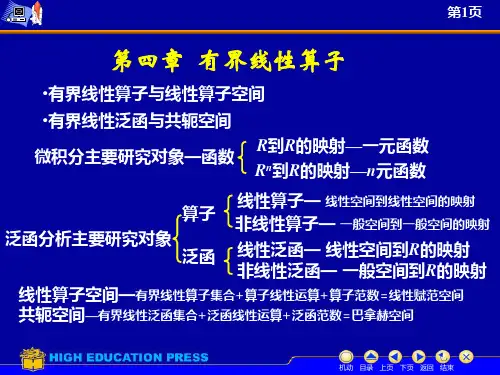
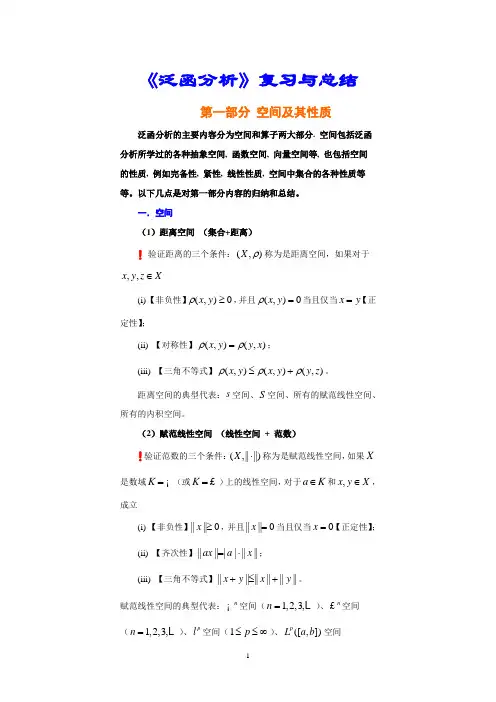
《泛函分析》复习与总结第一部分 空间及其性质泛函分析的主要内容分为空间和算子两大部分. 空间包括泛函分析所学过的各种抽象空间, 函数空间, 向量空间等, 也包括空间的性质, 例如完备性, 紧性, 线性性质, 空间中集合的各种性质等等。
以下几点是对第一部分内容的归纳和总结。
一.空间(1)距离空间 (集合+距离)!验证距离的三个条件:(,)X ρ称为是距离空间,如果对于,,x y z X ∈(i) 【非负性】(,)0x y ρ≥,并且(,)0x y ρ=当且仅当x y =【正定性】;(ii) 【对称性】(,)(,)x y y x ρρ=;(iii) 【三角不等式】(,)(,)(,)x y x y y z ρρρ≤+。
距离空间的典型代表:s 空间、S 空间、所有的赋范线性空间、所有的内积空间。
(2)赋范线性空间 (线性空间 + 范数)!验证范数的三个条件:(,||||)X ⋅称为是赋范线性空间,如果X是数域K =¡(或K =£)上的线性空间,对于a K ∈和,x y X ∈,成立(i) 【非负性】||||0x ≥,并且||||0x =当且仅当0x =【正定性】; (ii) 【齐次性】||||||||||ax a x =⋅;(iii) 【三角不等式】||||||||||||x y x y +≤+。
赋范线性空间的典型代表:n ¡空间(1,2,3,n =L )、n £空间(1,2,3,n =L )、p l 空间(1p ≤≤∞)、([,])p L ab 空间(1p ≤≤∞)、[,]Cab 空间、[,]k C a b 空间、Banach 空间、所有的内积空间(范数是由内积导出的范数)。
(3)内积空间 (线性空间 + 内积)!验证内积的四个条件:(,(,))X ⋅⋅称为是内积空间,如果X 是数域K =¡(或K =£)上的线性空间,对于a K ∈和,,x y z X ∈,成立(i) 【非负性】(,)0x x ≥,并且(,)0x x =当且仅当0x =【正定性】;(ii) 【第一变元可加性】(,)(,)(,)x y z x z x z +=+;(iii) 【第一变元齐次性】(,)(,)ax z a x z =;(iv) 【共轭对称性】(,)(,)x z z x =。
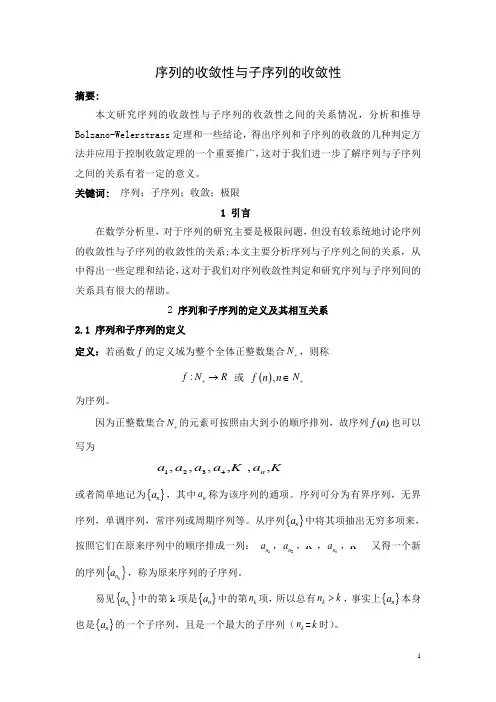
序列的收敛性与子序列的收敛性摘要:本文研究序列的收敛性与子序列的收敛性之间的关系情况,分析和推导Bolzano-Welerstrass 定理和一些结论,得出序列和子序列的收敛的几种判定方法并应用于控制收敛定理的一个重要推广,这对于我们进一步了解序列与子序列之间的关系有着一定的意义。
关键词: 序列;子序列;收敛;极限1 引言在数学分析里,对于序列的研究主要是极限问题,但没有较系统地讨论序列的收敛性与子序列的收敛性的关系;本文主要分析序列与子序列之间的关系,从中得出一些定理和结论,这对于我们对序列收敛性判定和研究序列与子序列间的关系具有很大的帮助。
2 序列和子序列的定义及其相互关系2.1 序列和子序列的定义定义:若函数f 的定义域为整个全体正整数集合N +,则称 :f N R +→ 或 (),f n n ∈N + 为序列。
因为正整数集合N +的元素可按照由大到小的顺序排列,故序列)(n f 也可以写为1234,,,,,,na a a a a 或者简单地记为{}n a ,其中n a 称为该序列的通项。
序列可分为有界序列,无界序列,单调序列,常序列或周期序列等。
从序列{}n a 中将其项抽出无穷多项来,按照它们在原来序列中的顺序排成一列: 1n a ,2n a , ,k n a , 又得一个新的序列{}k n a ,称为原来序列的子序列。
易见{}k n a 中的第k 项是{}n a 中的第k n 项,所以总有k n k >,事实上{}n a 本身也是{}n a 的一个子序列,且是一个最大的子序列(k n =k 时)。
2.2序列与子序列之间的若干关系定理1(Bolzano-Welerstrass ):若序列{}n a 有界,则必存在收敛子序列{}kn a ,若序列{}n a 无界,则必存在子序列{}k n a ,使kn a∞→(或k n a -∞→).证明:(1)不妨设{}n a 中有无限多个不同的项,否则结论显然成立.用有限覆盖定理(见注释①)来证明结论.设序列{}n a 为一有界序列,则存在,m M ,使 n m a M ≤≤ ()1,2,n =下面先证明在[],m M 中存在一点c ,使该点任一邻域内有{}n a 中的无穷多项.用反证法,若此断言不成立,则对任意[],a m M ∈都存在一邻域(),a a a a δδ-+,0a δ≠在此邻域内它有{}n a 中的有限项,()[]{},,,a a a a a m M δδA =-+∈构成[],m M 的一开区间覆盖.由有限覆盖定理,存在有限子覆盖,即存在*j a ()1,2,,j k = ,使 []()****1,,jjk j j a aj m M a a δδ=⊂-+依反证假设,()****1,jjk jj a a j aa δδ=-+ 中至多含有{}na 的有限项与()1,2,n m a M n ≤≤= 矛盾.据以上证明,存在()11,1n a c c ∈-+,又在11,22c c ⎛⎫-+ ⎪⎝⎭中,存在一项2n a 使21n n >,否则与c 的任何邻域中有{}n a 的无穷项矛盾,同样我们可以在11,33c c ⎛⎫-+ ⎪⎝⎭中找到一项3n a ,使32n n >> 在11,c c k k ⎛⎫-+ ⎪⎝⎭中找到一项k n a 使1k k n n ->> ,最终得到一个序列{}k n a 满足:(i ) {}k n a 是{}n a 的子序列(ii ) 1k n a c k-<于是,由(i )和(ii )知,k n a 是n a 的收敛子序列.(2)另外对于无界序列{}n a ,则可以利用序列无界定义,类似(1)后面一部分可以证明出存在子序列{}k n a ∞→.例1:对于有界序列(){}1k-,它存在子序列(){}21k-收敛于1,当k →∞.例2:对于无界序列{}n ,它的一切子序列都发散到+∞.以上是关于序列与其子序列在序列有界和无界的情况下进行的关系探讨,进一步对于单调有界序列分析,我们有如下定理:定理2:若{}n a 为单调有界序列,{}k n a 为{}n a 的一个子序列,且有k n a a →,()k →∞则有n a a → ()n →∞.证明:由于{}n a 是单调有界序列,可根据序列单调有界定理(见注释②)知道,{}n a 收敛,而lim n n a →∞存在,现假设记为b ,即l i m n n a b →∞=,由定义,对0ε∀>,∃1N ,使当1n N >时候,有2n a b ε-<由于{}k n a 是{}n a 的子序列,且k n a a → ()k →∞,故对上述0ε>,∃2N >0,使当k n >k >2N 时,就有2k n a a ε-<又取{}12max ,N N N =,当k N >时,就有2k n N >,于是有:2k n a b ε-<由k k k k n n n n b a b a a a b a a a -=-+-<-+-=k k n n a b a a -+-22εε<+=ε即有 a b =成立,所以lim n x a a →∞=成立.例 3设序列n a =,{}2k a 为{}n a 的一个子序列且有22k a →,()k →∞, 则有2n a → ()n →∞.3 序列与子序列的三个定理定理3:序列{}n x 收敛于a 的充要条件是它的任何子序列{}k n x 也都收敛于同一个极限a .证明:依题意,设lim n n x a →∞=,{}k n x 为{}n x 的一个子序列,于是对于任给的0ε>,存在N ,使得n N >当时就有n x a ε-<,因为{}k n x 是{}n x 的子序列,故有k n k ≥,所以当k N >时, k n N >, 从而有:k n x a ε-<按照序列极限定义知lim n n x a →∞=,即{}k n x 收敛且与{}n x 的极限相同.反之若序列{}n x 的任一子序列都收敛,且有相同的极限a ,因为{}n x 本身为自己的一个子序列,所以有lim n n x a →∞=.定理4:序列{}n a 收敛的充要条件是奇子序列{}21k a -与偶子序列{}2k a 都收敛,且它们的极限相等.证明:根据定理3,序列{}n a 的奇子序列{}21k a -与偶子序列{}2k a ,且它们的极限相等.设212lim lim k k k k a a a -→∞→∞==.根据序列极限的定义,即1121222,21,.0,,2,.k k k N k k a a k N k k a a εεε-⎧∃∈∀->-<⎪∀>⎨∃∈∀>-<⎪⎩有有{}12max ,.N k k ∃=于是,n N ∀>,有 n a a ε-<,即 lim n n a a →∞=. (证毕)定理5:若序列{}n x 收敛于a 的充要条件是{}n x 的任一子序列{}k n x 中必有子序列{}'n k x ,使得'n k x a →()k →∞.证明:由定理3我们可以知道: 若序列{}n x 收敛于a ,则它的任何子序列{}k n x 也都收敛于同一个极限a ,由题意必要性得证.已知序列{}n x 的任一子序列{}kn x 中必有子序列{}'n kx,使得'n kxa →()k →∞,则由定理3有n k x a →()k →∞.用反证法,假设lim n x x a →∞≠则必然存在00ε>,对于任意自然数N ,都有00n >时,有00n x a ε-≥当1N =时,11n >,使 10n x a ε-≥ 当1N n =时,有12n n >,使 20n x a ε-≥ …………当1k N n -=时,有1k k n n ->,使0k n x a ε-≥ …………由此可以得到{}n x 的一个子序列{}k n x ,它的每一项k n x 都满足0k n x a ε-≥,故{}k n x 不收敛于a ,且{}k n x 中不存在收敛于a 的子序列, 这与已知矛盾,因此lim n n x a →∞=成立。

泛函分析小论文论文题目:赋范线性空间中的强收敛、弱收敛和一致收敛专业: 数学科学学院年级: 12级姓名: 乌日罕学号: 126任课教师:韩刚赋范线性空间中的强收敛、弱收敛和一致收敛摘要:对赋范线性空间中的强收敛、弱收敛和一致收敛进行初步的认识。
首先引进了强收敛、弱收敛和一致收敛的定义、概念,其次讨论了一些相关的例题,最后,给出并证明了定理(强收敛充要条件)。
关键词:强收敛;弱收敛;一致收敛;赋范线性空间一、有关定义、相关的例题及其解析定义1设X是赋范线性空间,X X∈X,X=1,2,…,如果∃X∈X,s.t.‖X X−X‖→0(X→∞),则称点列{X X}强收敛于X,如果对∀X∈X′,都有X(X X)→X(X)(X→∞),则称点列{X X}弱收敛于X,记为X X 弱→X(X→∞).※在此注意的是,X X→X(X→∞)⇒X X弱→X,反之不然。
显然强收敛必定弱收敛,但弱收敛不一定强收敛。
例1(弱收敛≠>强收敛)设X=X2,X X=(0,0,…,0,1,0,…),X=1,2,…,则‖X X‖= 1,故{X X}不强收敛于0.下证{X X}弱收敛于0,对∀X∈(X2)∗=X2,即X=(X1,X2,…)∈X2⇔∑|X X|2∞X=1<+∞.X(X X)=X X→0(X→∞)( ∴|X(X X)−0|→0(X→∞)∴X(X X)弱→0(X→∞) )定义2设X是赋范线性空间,X′是X的共轭空间,泛函列X X∈X′(X=1,2,…),如果∃X∈X′,s.t.(1)‖X X−X‖→0(X→∞),则称{X X}强收敛于X;(2)对∀X∈X,都有|X(X X)−X(X)|→0(X→∞),则称{X X}弱*收敛于X;(3)若对∀X∈(X′)′,都有X(X X)→X(X)(X→∞),则称{X X}弱收敛于X.※在此注意的是,1.弱*收敛与弱收敛一般是不同的,但若X是自反的(X∗∗=X,(X2)∗=X2,(X X)∗=X X)则泛函列{X X}的弱*收敛与弱收敛等价。

4.1有界线性算⼦第4章线性算⼦与线性泛函4.1 有界线性算⼦4.1.1 线性算⼦与线性泛函算⼦概念起源于运算。
例如,代数运算、求导运算、求不定积分和定积分、把平⾯上的向量绕坐标原点旋转⼀个⾓度等等。
在泛函分析中,通常把映射称为算⼦,⽽取值于实数域或复数域的算⼦也称为泛函数,简称为泛函。
本章着重考察赋范线性空间上的线性算⼦,它是出现在各个数学领域中具有线性性质的运算(例如线性代数中的线性变换;微分⽅程论、积分⽅程论中⼤量出现的微分、积分运算、积分变换等)的抽象概括。
它是线性泛函分析研究的重要对象。
关于线性算⼦的理论不仅在数学的许多分⽀中有很好的应⽤,同时也是量⼦物理的数学基础之⼀。
中国物理学界习惯上把算⼦称为算符。
定义4.1.1 设F 是实数域或复数域,,X Y 是F 上的两个线性空间,D 是X 的线性⼦空间,:T D Y →是⼀个映射.对x D ∈,记x 经T 映射后的象为 Tx 或 ()T x . 若对,x y D ?∈及数,αβ∈F , 有()()()T x y T x T y αβαβ+=+(或 Tx Ty αβ=+) (4.1.1)则称T 是线性算⼦.称D 是T 的定义域,记为()T D ;称集(){}T D Tx x D =∈(或TD )为T 的值域(或象域),记为()T R .取值为实数或复数的线性算⼦T (即:()T ?F R , 1=F R 或1C )分别称为实的或复的线性泛函,统称为线性泛函。
注今后所讨论的算⼦(泛函)都是线性算⼦(线性泛函)。
例4.1.1 设1[0,1],[0,1]X C Y B ==([0,1]上有界函数全体),定义d()()()d Tx t x t t=, 则T 是X 到Y 的线性算⼦。
例4.1.2 设[,]X C a b =,(,)K t s 是[,][,]a b a b ?上的⼆元连续函数,定义()()(,)()d baTx t K t s x s s =?,则T 是X 到X 的线性算⼦。
3.4 线性算子的基本定理汉恩-巴拿赫延拓定理、逆算子定理、闭图像定理以及共鸣定理是泛函分析的四大基石,证明具有一定的技巧,应用非常广泛.前面已经学习了Hahn-Banach 定理,知道一般的线性赋范空间X 中存在足够多的线性连续泛函,从而使共轭空间的研究才有意义.本节探讨其它三个重要的定理.汉恩-巴拿赫延拓定理(The Hahn-Banach Theorem)定理 设G 为线性赋范空间X 的线性子空间,f 是G 上的任一线性有界泛函,则存在X 上的线性有界泛函F ,满足(1) 当x G ∈时,()()F x f x =; (2) XGF f=.其中XF表示F 作为X 上的线性泛函时的范数;Gf表示G 上的线性泛函的范数.延拓定理被应用于Riesz 定理、Liouville 定理的证明及二次共轭空间等的研究中.3.4.1 逆算子定理(The Inverse Mapping Theorem)在微积分课程中介绍过反函数的概念,并且知道“单调函数必存在反函数”,将此概念和结论推广到更一般的空间.定义3.4.1 逆算子(广义上)设X 和Y 是同一数域K 上的线性赋范空间,G X ⊂,算子T :G Y →,T 的定义域为()D T G =;值域为()R T .用1T -表示从()()R T D T →的逆映射(蕴含T 是单射),则称1T -为T 的逆算子(invertiable operator).定义3.4.2 正则算子设X 和Y 是同一数域K 上的线性赋范空间,若算子T :()G X Y ⊂→满足 (1)T 是可逆算子; (2) T 是满射,即()R T Y =; (3) 1T -是线性有界算子, 则称T 为正则算子(normal operator).注1 ①若T 是线性算子,1T -是线性算子吗?②若T 是线性有界算子,1T -是线性有界算子吗?性质3.4.1 若T :()G X Y ⊂→是线性算子,则1T -是线性算子. 证明 12,y y Y ∈,,αβ∈K ,由T 线性性知:1111212(())T T y y T y T y αβαβ---+--1111212()TT y y TT y TT y αβαβ---=+--1212()y y y y αβαβ=+--0=由于T 可逆,即T 不是零算子,于是1111212()T y y T y T y αβαβ---+=+,故1T -是线性算子.□定理3.4.1逆算子定理设T 是Banach 空间X 到Banach 空间Y 上的双射(既单又满)、线性有界算子,则1T -是线性有界算子.例 3.4.1 设线性赋范空间X 上有两个范数1⋅和2⋅,如果1(,)X ⋅和2(,)X ⋅均是Banach空间,而且2⋅比1⋅强,那么范数1⋅和2⋅等价.(等价范数定理)证明 设I 是从由2(,)X ⋅到1(,)X ⋅上的恒等映射,由于范数2⋅比1⋅强,所以存在0M >,使得x X ∀∈有112Ix x M x =≤于是I 是线性有界算子,加之I 既是单射又满射,因此根据逆算子定理知1I -是线性有界算子,即存在0M'>,使得x X ∀∈有1212I xx M'x -=≤.故范数1⋅和2⋅等价.□3.4.2 闭图像定理(The Closed Graph Theorem)学习微积分时,我们知道闭区间[,]a b 上的函数()y f x =图形是xoy 平面上的一条曲线,即为2R 中的一个点集(){(,)(),[,]}G f x y y f x x a b ==∈,特别当()[,]f x C a b ∈,这个点集()G f 为2R 中的闭集,现在将此结论推广到更一般的线性赋范空间上.定义3.4.3 线性赋范空间的乘积设X 和Y 是同一数域K 上的线性赋范空间,考虑直积集{(,),}X Y x y x X y Y ⨯=∈∈,1122(,),(,)x y x y X Y ∀∈⨯,α∀∈K ,在X Y ⨯上定义加法和数乘,11221212(,)(,)(,)x y x y x x y y +=++,1111(,)(,)x y x y ααα=那么X Y ⨯构成线性空间.设,x X y Y ∈∈,其范数分别为,x y ,于是在X Y ⨯上可定义范数1(,)()p pppx y x y =+(1)p ≤<+∞,(,)max(,)x y x y ∞=最常用的是1(,)x y x y =+,12222(,)()x y x y =+,(,)max(,)x y x y ∞=,可证明这些范数都是X Y ⨯上的等价范数.此时称X Y ⨯为X 和Y 的乘积空间.注2 通过上述范数的定义可知乘积空间X Y ⨯是线性赋范空间,于是在X Y ⨯中就有了开集、闭集、列紧集、收敛列、完备性等概念和相应的结论.例如点列{(,)}n n x y X Y ⊂⨯收敛于00(,)x y 当且仅当0000(,)(,)(,)0n n n n x y x y x x y y -=--→.同时易证00(,)(,)n n x y x y →⇔00,n n x x y y →→,可见若F X Y ⊂⨯,F 闭集的的充要条件为:(,)n n n A x y F ∀=∈,若(,)n A A x y →=,即n x x →,n y y →,则有A F ∈.定义3.4.4 闭算子设X 和Y 是同一数域K 上的线性赋范空间,若T 的图像(){(,),()}G T x y y Tx x D T ==∈是乘积空间X Y ⨯的闭子集,则称T 为闭线性算子,简称闭算子.引理3.4.1 设X 和Y 是同一数域K 上的线性赋范空间,T :()G X Y ⊂→是线性算子,那么T 为闭线性算子⇔()n x D T ∀∈,当n x x X →∈,n Tx y Y →∈时,必有()x D T ∈且Tx y =.证明 ⇒如果T 为闭线性算子,那么当()n x D T ∈,n x x X →∈,n Tx y Y →∈时,显然有{(,)}()⊂n n x Tx G T ,而且在乘积空间X Y ⨯中有(,)(,)n n x Tx x y →,由于()G T 是X Y ⨯中的闭集,故(,)()x y G T ∈,即()x D T ∈,Tx y =.⇐(,)()n n x Tx G T ∀∈,当(,)(,)n n x Tx x y →时,显然有n x x →,n Tx y →,由条件知()x D T ∈且Tx y =.于是(,)(,)()x y x Tx G T =∈,即()G T 中的每一收敛点列的极限都在()G T 中,所以()G T 是闭集,即T 为闭线性算子.□注3 对于线性算子而言,已有三个主要的概念:连续性、有界性和闭性,其中连续性和有界性等价,因此,需要研究“线性有界算子”与“闭线性算子”之间的关系.定理3.4.2 设T :()()D T X Y ⊂→是线性有界算子,如果()D T 是X 的闭线性子空间,那么T 为闭线性算子.证明 设()n x D T ∈且有n x x X →∈,n Tx y Y →∈.因为()D T 是X 的闭线性子空间,所以()x D T ∈;又因为T 有界,即连续算子,所以lim lim n n n n y Tx T x Tx →∞→∞===故根据上述引理可得T 为闭线性算子.□注4 当()D T X =时,若T :X Y →是线性有界算子,则由定理知T 为闭算子. 定理3.4.3 闭图像定理设X 和Y 都是Banach 空间,T :()()D T X Y ⊂→是闭线性算子,()D T 是X 的闭线性子空间,那么T 为线性连续算子.证明 略.推论3.4.1 设X 和Y 都是Banach 空间,()T X Y ∈→,那么T 为线性有界算子⇔T 为闭算子.例3.4.2 设[0,1]X C =,(1)(){()[0,1]}[0,1]D T x X x't C C =∈∈=,定义微分算子D :()D T X→如下:()x D T ∀∈,()dx x t dt=D ,则D 是闭算子,但是D 无界的. 证明 由第三节例3.3.3后的反例知:令()()[0,1]n t a n x t e C --=∈,可得()[,]max 1n t a n t a b x e --∈==;n x n =→∞D知T 是无界的.下证T 是闭算子.设()n x D T ∈,且n x x →,n Tx y →.因为在[0,1]C 中的收敛是函数列的一致收敛,由()()()'n n x t Tx t y t =→,即()'n x t 在[0,1]C 上一致收敛()y t ,所以有0()lim ()tt 'n n y d x d ττττ→∞=⎰⎰0lim ()t'n n x d ττ→∞=⎰lim[()(0)]n n n x t x →∞=-()(0)x t x =-即0()(0)()tx t x y d ττ=+⎰,从而()()x t D T ∈ ,且()()Tx x't y t ==,根据上述引理3.4.1(闭算子的等价条件)知,T 是闭算子.□例3.4.2说明算子的闭性不蕴含有界,下面的例子则说明有界也不蕴含闭性.例 3.4.3 设[,]X C a b =,()[,]D T P a b =是[,]a b 上的实系数多项式函数的全体,再令:()[,]T D T C a b →是恒等算子,那么T 是线性有界算子,但T 不是闭算子.证明 因为()x D T ∀∈,Tx x =,所以显然有T 是线性有界算子.令()sin ()x t t X D T =∈-,由于()[,]D T P a b =在X 中稠密,所以存在点列{}()n x D T ⊂,使得()n x x n →→∞,即n n Tx x x =→,但是(,)(sin ,sin )()x Tx t t G T =∉,故T 不是闭算子.□3.4.3 共鸣定理(The Banach-Steinhaus Theorem)在许多数学问题中,常常会遇到一族算子的有界问题,而不是仅仅考虑某一个算子的有界问题,即需要讨论这一族线性有界算子在什么条件下一致有界?要回答这一问题,涉及到如下在理论和应用上大都十分重要的定理——共鸣定理.定义3.4.5 一致有界设X 和Y 是同一数域K 上的线性赋范空间,()F B X Y ⊂→,如果{ }T T F ∈是有界集,则称算子族F 为一致有界.定理3.4.4 共鸣定理设X 是Banach 空间,Y 是线性赋范空间,算子族()F B X Y ⊂→,那么{ }T T F ∈是有界集(F 一致有界)⇔x X ∀∈,{ }Tx T F ∈为有界集.证明 (1) 必要性⇒ 因为{ }T T F ∈是有界集,所以存在0M >,T F ∀∈,有T M ≤,于是x X ∀∈,不妨设x a =,那么Tx T x M x M a ≤≤≤⋅因此{ }Tx T F ∈为有界集.(2) 充分性⇐x X ∀∈,定义sup FT Fx x Tx ∈+ ,显然F ⋅是X 上的范数且比⋅强,下面证明(,)F X ⋅完备.如果s u p ()0m nm n m n FT Fx x x x T x x ∈-=-+-→(,)m n →∞,由X 是Banach 空间知存在x X ∈,使得0n x x -→()n →∞.又因为0ε∀>,N ∃∈N ,使得只要,m n N ≥,便有sup m n T FTx Tx ε∈-<.从而T F ∀∈有n n m m Tx Tx Tx Tx Tx Tx -=-+-n m m Tx Tx T x x ≤-+-0→()n →∞.因此得sup ()0n n T Fx x T x x ∈-+-→()n →∞,即0n Fx x-→,可见(,)F X ⋅完备.根据等价范数定理知范数F ⋅和⋅等价,从而存在0M >,使得x X ∀∈有sup sup FT FT FTx x Tx xM x ∈∈≤+=≤于是可得T F ∀∈有T M ≤.□注5 共鸣定理也称为一致有界定理(或原理),由共鸣定理知,当F 不一致有界时,即sup{ }T T F ∈=∞,则存在0x X ∈,使得0sup{ }Tx T F ∈=∞,称0x 为算子族F 的共鸣点.例3.4.4 设无穷矩阵111212122212j j i i ij a a a a a a A a a a ⎛⎫ ⎪ ⎪ ⎪= ⎪ ⎪ ⎪⎝⎭满足21ij i a ∞=<∞∑,1,2,3,j = ,并对任何212(,,,,)i x x x x l =∈ 有Tx xA =11121212221212(,,,,)j j i i i ij a a a a a a x x x a a a ⎛⎫ ⎪ ⎪ ⎪= ⎪ ⎪ ⎪⎝⎭12(,,,,)i y y y = 2y l =∈其中1j i ij i y x a ∞==∑,1,2,j = ,证明算子T 是线性连续算子.证明 显然22()T l l ∈→是线性算子,又知2l 是Banach 空间,所以由闭图像定理知,算子T 连续等价于T 是闭算子.设2{}n x l ⊂,()n x x n →→∞,2n Tx y l →∈,下面证明y Tx =.记12(,,,,)i x x x x = ;00012(,,,,)j Tx y y y = ;12(,,,,)j y y y y = ;12(,,,,)n nn n i x x x x = ;12(,,,,)n n n n j Tx y y y = .由n Tx y →知,对每一个j 而言,有1221()nn jj jj j y y y y ∞=-≤-∑0→ (n →∞)另一方面对每一个j 有01()n n jji i ij i y y xx a ∞=-=-∑1()n i i ij i x x a ∞=≤-∑11222211()()n ij ii i i a x x ∞∞==≤-∑∑1221()ij n i a x x ∞==-∑0→ (n →∞)所以0j j y y =,即y Tx =.由闭算子的等价条件知T 是闭线性算子.□例3.4.5 (Fourier 级数的发散问题) 存在一个周期为2π的实值连续函数,它的Fourier 级数在0t =点发散.证明 记周期是2π的实值连续函数全体为2C π,对于2f C π∈,f 导出的Fourier 级数为:011(cos sin )2n n n a a nt b nt ∞=++∑,其中 1()cos d n a f t nt t πππ-=⎰ (0,1,2,n = );1()sin d n b f t nt t πππ-=⎰ (1,2,3,n = ).当0t =时,级数为0112n n a a ∞=+∑,前1n +项部分和为01111()()[12cos ]d 22nnn n n n S f a a f t nt t πππ-===+=+∑∑⎰记1()12cos nn n K t nt ==+∑,计算可得1sin()2()sin 2n n tK t t +=(计算略),于是 1()()()d 2n nS f f t Kt t πππ-=⎰.下面证明存在2f C π∈,使得{()}n S f 发散.显然2:n S C π→R 是线性泛函.又因为[,]1()max {()}()d 2n nt S f f t Kt t πππππ-∈-≤⋅⎰n M f ≤⋅其中1()d 2n nM Kt t πππ-=⎰,所以n S 是2C π上的线性连续泛函.可证明n S 的范数为1()d 2n n nS M Kt t πππ-==⎰(证明略).由于2C π是Banach 空间,为了证明存在2f C π∈,使得{()}n S f 无界,根据共鸣定理,只需证{}n S 无界.因为1sin()12d 12sin 2n n t S t t πππ-+=⎰202sin(21)d sin n s s s ππ+=⎰ (2t s =) (1)22(21)02(21)sin(21)2d k nn k k n n ss sπππ++=++≥∑⎰(1)2202sin 2d k nk k u u uπππ+==∑⎰((21)u n s =+)(1)220222sin d (1)k nk k u u k ππππ+=≥+∑⎰(1)2220241sin d 1k nk k u u k πππ+==+∑⎰ 2220041sin d 1nk u u k ππ==+∑⎰22411nk k π==+∑→∞所以{}n S 无界.□。
线性有界算子序列的一致强(弱)收敛线性有界算子序列的一致强(弱)收敛,指的是在定义在线性变换
空间上的有界算子序列\{T_n\}中,存在一个定义在这个空间里的数K,使得||T_n||\leqK,并且当n\rightarrow\infty时,T_{n}以足够快
的速度向T趋近,其中||T_n||是这个序列的算子范数,T是这个空间
的有界算子。
首先要说的是,线性有界算子序列的一致强收敛,是指一个线性
变换空间上的有界算子序列,它具有线性复叱性,并且有数K使得
||T_n||\leqK,当n\rightarrow\infty时,T_n和T的定义范围趋于
一致,这个过程使得T_n不断次级收敛到T(若T是收敛点,则T也收敛到T,而T_n不断增加,最终收敛到T),使得T_n等效于T,称为
一致强收敛。
由于一致强收敛的定义具有线性复叱性,所以我们可以得出抽象
的总结:T_n的一致强收敛类似于一致收敛,但是它不是以完全一致的方式,而是以不断次级的形式收敛的,最终收敛到某个点T,即T_n等于T,称为一致强收敛。
另外,线性有界算子序列的一致弱收敛是指在定义在线性变换空
间上的有界算子序列中,存在一个定义在这个空间里的数K,使得
||T_n||\leqK,而且当n\rightarrow\infty时,T_{n}不断向T靠近,但动态幅度很小,最终没有达到等同于T,也就是T_n不能真正等效于T,但它们之间的差异趋于零,称为一致弱收敛。
总之,线性有界算子序列的一致强(弱)收敛,指的是在定义在线
性变换空间上的有界算子序列\{T_n\}中,存在一个定义在这个空间里
的数K,使得||T_n||\leqK,并且当n\rightarrow\infty时,有一致
强收敛和一致弱收敛,也就是说,T_n以不同的范围靠近T,使得T_n
逐渐收敛到T,从而减少了两者之间的偏差,使其有效的趋近于T,最
终达到稳定的状态。